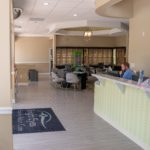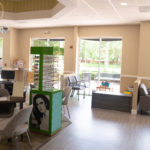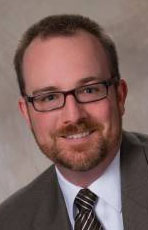
The entrance and check-in desk area of Dr. Bonilla-Warford’s newly expanded office.
By Nathan Bonilla-Warford, OD, FAAO, FCOVD
July 22, 2020
When our lease was up on our old space, we realized we had an opportunity to expand space and services. Here is how we enlarged our office space, and what that additional space has meant to the care we can provide and our profitability, and how it is helping us through the current challenges of social distancing.
More Room for a Growing Practice Niche
Pediatrics, including vision therapy, is a major practice niche for us. Prior to the expansion, we had a primary office that was 1,600 sq. ft. with two exam rooms and one vision therapy room. We expanded that location into the 2,000 sq. ft. space next door, so now we have three exam rooms and three vision therapy rooms and other features.
One problem we had before was that we wanted more staff, but did not have enough workspace for them. Since the expansion, we have hired a part-time optometrist, an additional vision therapist, an additional optician and a part-time front-desk person. These needs were determined based on increased patient flow and a desire to do more community outreach and marketing.
In addition, we wanted more optical lab space for an in-house edger and a conference room for staff meetings and meetings with industry representatives. We also wanted to create a more open, fresh optical area with increased dispensing tables.
There have been other benefits to the greater office space: We have larger patient reception areas and a larger, more comfortable break room from for staff. Now that we have increased vision therapy space, we would like to add more specialized sports-vision services.

The optical in Dr. Bonilla-Warford’s expanded office.
How Much Did It Cost?
We budgeted about $250,000 for construction, flooring, exam room equipment, edging equipment, computers, vision therapy equipment, furnishings, storefront signage, etc. This was almost exactly our final cost – when expenses were higher in one area, we cut expenses in others to stay within our budget.
One challenge that we didn’t foresee was the degree to which our revenue would drop during the expansion. Because we had to move out of the old space, we had to set up a temporary front desk and exam rooms in the new space. Having one fully functional exam room limited our patient flow. We knew this was going to happen, but we underestimated how long it would take.
Old & New: Compare the Floor Plans
What has ROI for the Expansion Been Like?
Since the expansion allows us to see more patients, especially in our specialty areas, we anticipate a great return on investment over the next 10 years. Hopefully, we will be able to break even in less than two years.
Conventional wisdom says that moving, or redesigning, an office results in an increase in both patient volume and revenue per patient. We have found this to be true. The month after completion was our highest revenue-producing month ever.
Other Articles to Explore
Tackling the Expansion in Stages
The expansion happened in stages: planning, build-out of the acquired space, moving everything from old space to new space, build-out and remodel of old space to match the new space, breaking through to combine the spaces, moving back into the old space, and finally, fine-tuning patient flow.
Take Time to Prepare Your Staff When Expanding Space
Everyone knows that construction projects frequently run over budget and take longer than expected, but we didn’t fully prepare for this. It became difficult as the expansion stretched into summer, which is one of our busiest seasons. Additionally, now that we have a larger staff, we didn’t fully anticipate how the stress of the expansion would affect them. We should have done more to prepare them and help them deal with the stress of the project.
Our New Space Helping Us Stay Safe & Strong During the Pandemic
Like all optometrists, in March and April of this year, we faced many unprecedented choices with incomplete information. We followed Centers for Disease Control recommendations and closed our office for routine care for six weeks.
To maintain what revenue we could, we continued to see patients with urgent medical eyecare issues and converted our vision therapy program into a telemedicine format. There was tremendous anxiety about the lost revenue with many fixed costs. I was starting to second guess both the expense of the expansion and the additional rent that we were paying on the space.
Now that we are back open for routine care, my staff and I are very thankful that we proceeded with the expansion. Previously, we had a small reception area that did not allow for social distancing. We did not have a separate diagnostic room, which previously made patient flow difficult, and now would be nearly impossible. The optical was crowded with only one dispensing desk. Now we have four so that people can spread out comfortably.
Given the expanded space, we are able to see a nearly full patient load safely. Despite the extra steps that are necessary to safely see patients during the pandemic, we are able to continue to practice profitably and provide employment for our staff.
 Nathan Bonilla-Warford, OD, is the owner of Bright Eyes Family Vision Care in Tampa, Fla. To contact him: natebw@gmail.com
Nathan Bonilla-Warford, OD, is the owner of Bright Eyes Family Vision Care in Tampa, Fla. To contact him: natebw@gmail.com

























